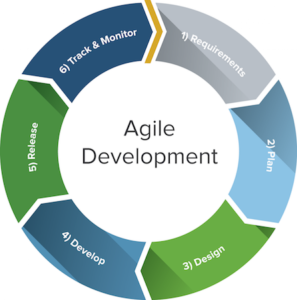In our last blog post, we introduced Agile Development, talked about what it meant, and ran through a few of the benefits that Agile Development can bring to the project itself, project management, business or organization. In this blog post, we stay with the Agile theme.
This time, we look at examples of Agile in real life and how some businesses are deploying Agile Development to their benefit. By the time you’ve read this article, you’ll have an even more in-depth understanding of how Agile Development might help you.
Why Firms Use Agile Methodology
First, a quick recap of some of the reasons why businesses and organizations around the world adopt Agile project management and development practices! Some of these benefits include, but are not limited to:
- Quick response to constant changes in the market during the software development process
- Focus on continuous delivery thereby resulting in quicker software releases
- Reduction of wasted work / wasted time resulting in increased productivity and efficiency
- Improved visibility and being able to identify potential show-stoppers before they become an issue
These are just some of the benefits businesses are realizing.
Agile Methodology Examples in Real Life

Sky
Sky might be a household name famous for its satellite TV, broadband and telephone services but the media provider is almost making a name for itself in software development. The company which has launched products to combat the likes of Apple’s TV Box has been placing Agile methodologies and open source at the center of their software development approach.
For example, Tufan, a Delivery Manager from Sky went onto mention:
When I joined Sky in 2005 it was about the same time that we were starting to embrace Agile software development. Traditionally, software was mainly created using the Waterfall working method. This technique would see software flowing downwards through concept, analysis, development and testing before being released to customers. Although it was widely recognized in the industry, it was slow to deliver and there was little collaboration between analysts, developers or testers. The pace of innovation was increasing much like it is today. And it was clear that Sky was outgrowing the waterfall principles.
New and old projects were converted to Agile which is based on the idea that software is developed through collaboration between self-organizing and cross-functional teams. It also encourages software to be released as quickly and regularly as possible. Converting to Agile wasn’t easy. It involved significant changes in attitudes and mindsets and the removal of well-known processes.
Source: Sky
Philips
Philips is another firm that has adopted Agile principles. After numerous changes to management structure, the firm introduced several Agile coaches that went to deploy Scrum principles such as Scrum boards and breaking down teams into smaller ones. As a result of changes like this, teams could react to situations quicker, bureaucracy was removed, and it was ultimately easier for these smaller teams to take responsibility for their respective products.
VistaPrint
VistaPrint is the go-to marketing company for small businesses. The company performed some analysis of their existing waterfall methodology and found that teams were taking more than 60 days to move from the “ideation phase” to product delivery! The 60-day cycle only amounted to 40 hours of actual work!
The company looked further into why this was the case, it transpired that unclear decisions and long creative lead times were to blame, all of which resulted in feedback loops. Round and round it went!
VistaPrint decided to switch to Agile practices with a focus on decreasing project lead time. By introducing daily stand-ups, Kanban Boards and idea pipelines, VistaPrint was able to optimize their business processes and saw their Lead Time decrease from 40 days down to 15!
BBVA
A few years ago, BBVA started shifting to Agile practices in Spain, due to the success of deploying Agile it decided to bring the methodology to other countries such as the USA.
For example, one project where agile principles were deployed was an application that consumers could use called BVA Wallet. The application lets consumers manage their payment cards. The firms head of business development went onto say that:
“With agile methodology, we could develop and very rapidly have new releases”
And that due to Agile, BBVA has:
“come out with a lot of other functionality like the ability to block and unblock cards, the ability to acquire a new card or cancel a card and the ability to convert a card payment into installments.”
You can see here that BBVA is realizing some of the great benefits of Agile Developments can bring a project such as predictable and rapid software delivery, thereby reducing the time to market for their new products and services.
JP Morgan Chase
Another banking institution that needs no introduction is JP Morgan Chase. A few years ago, the baking giant overhauled their business processes to help improve product development and simultaneously slashed the cost of training as part of a high-profile IT initiative. Agile methodologies were a key part of the initiative.
The initiative involved the extensive redevelopment of key platforms, and in some instances, multiple legacy systems.
Mike Cavanagh, one of the division heads at JP Morgan Chase said that “technology was enabling the bank to “optimize the location strategy” of staff, with an increase of the percentage working in low-cost sites from 26 to 40 percent. The use of Agile development methodology was also enabling faster application deployment and better functionality”.
James Young, managing director and CIO of the Digital Group also commented on some of the benefits that Agile development has brought:
“We’ve got multidiscipline teams that sit together; product design, technology quality assessment, all work together in relatively small teams focused around product features, and work on the requirements that result in a daily build”
And that – “Every day we can demonstrate an improvement to the site,” Young said. “And every three weeks we’ve got a ship of a product. This translates into great predictability in terms of what we build.”
JP Morgan Chase has really adopted Agile and being able to ship product every three weeks is a massive productivity boost. All of this is made possible by faster, more nimble and responsive teams that Agile frameworks promote.
Summary
In this article, we’ve looked at how real life examples of Agile methodology are being successfully deployed. We’ve looked at why firms use Agile in project management and why major players such as Sky, Philips and JP Morgan Chase all use Agile to enhance their business processes.
Here at Growth Acceleration Partners, we have extensive expertise in many verticals. Our nearshore business model can keep costs down whilst maintaining the same level of quality and professionalism you’d experience from a domestic team. Learn options for modernizing and optimizing your infrastructure.
Our Centers of Engineering Excellence in Latin America focus on combining business acumen with development expertise to help your business. We can provide your organization with resources in the following areas:
- Software development for cloud and mobile applications
- Data analytics and data science
- Information systems
- Machine learning and artificial intelligence
- Predictive modeling
- QA and QA Automation
If you’d like to find out more, then visit our website here. Or if you’d prefer, why not arrange a call with us?



